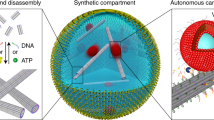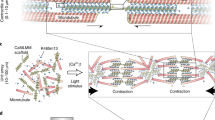Abstract
The synthesis of conductive nanowires or patterned conductive nanoelements is a challenging goal for the future fabrication of nanoscale circuitry1. Similarly, the realization of nanoscale mechanics might introduce a new facet to the area of nanobiotechnology. Here we report on the design of conductive and patterned actin-based gold nanowires, and on the ATP-driven motility of the nano-objects. The polymerization of G-actin labelled with Au nanoparticles, followed by the catalytic enlargement of the nanoparticles, yields gold wires (1–4 μm long and 80–200 nm high) exhibiting high electrical conductivity. The polymerization of the Au nanoparticle/G-actin monomer followed by the polymerization of free G-actin, or alternatively the polymerization of the Au-nanoparticle-labelled G-actin on polymerized F-actin followed by the catalytic enlargement of the particles, yields patterned actin–Au wire–actin or Au wire–actin–Au wire nanostructures, respectively. We demonstrate the ATP-fuelled motility of the actin–Au wire–actin filaments on a myosin interface. These actin-based metallic wires and their nanotransporting funcionality introduce new concepts for developing biological/inorganic hybrid devices.
This is a preview of subscription content, access via your institution
Access options
Subscribe to this journal
Receive 12 print issues and online access
$259.00 per year
only $21.58 per issue
Buy this article
- Purchase on Springer Link
- Instant access to full article PDF
Prices may be subject to local taxes which are calculated during checkout




Similar content being viewed by others
References
Niemeyer, C.M. Nanoparticles, proteins, and nucleic acids: biotechnology meets materials science. Angew. Chem. Int. Edn 40, 4128–4158 (2001).
Braun, E., Eichen, Y., Sivan, U. & Ben-Yoseph, G. DNA-templated assembly and electrode attachment of a conducting silver wire. Nature 391, 775–778 (1998).
Patolsky, F., Weizmann, Y., Lioubashevski, O. & Willner, I. Au-nanoparticle nanowires based on DNA and polylysine templates. Angew. Chem. Int. Edn 41, 2323–2327 (2002).
Richter, J. et al. Construction of highly conductive nanowires on a DNA template. Appl. Phys. Lett. 78, 536–538 (2001).
Mertig, M. et al. DNA as a selective metallization template. Nano Lett. 2, 841–844 (2002).
Manson, C.F. & Wooley, A.T. DNA-templated construction of copper nanowires. Nano Lett. 3, 359–363 (2003).
Scheibel, T. et al. Conducting nanowires built by controlled self-assembly of amyloid fibers and selective metal deposition. Proc. Natl Acad. Sci. USA 100, 4527–4532 (2003).
Reches, M. & Gazit, E. Casting metal nanowires within discrete self-assembled peptide nanotubes. Science 300, 625–627 (2003).
Keren, K. et al. Sequence-specific molecular lithography on single DNA molecules. Science 297, 72–75 (2002).
Yildiz, A. et al. Myosin V walks hand-over-hand: single fluorophore imaging with 1.5-nm localization. Science 300, 2061–2065 (2003).
De La Cruz, E.M. The kinetic mechanism of myosin V. Proc. Natl Acad. Sci. USA 96, 13726–13731 (1999).
De La Cruz, E.M. Kinetic mechanism and regulation of myosin VI. J. Biol. Chem. 276, 32373–32381 (2001).
Mehta, A. Myosin learns to walk. J. Cell Sci. 114, 1981–1998 (2001).
Yanagida, T. & Iwane, A.H. A large step for myosin. Proc. Natl Acad. Sci. USA 97, 9357–9359 (2000).
Vale, R.D. & Milligan, R.A. The way things move: looking under the hood of molecular motor proteins. Science 288, 88–95 (2000).
Rief, M. et al. Myosin-V stepping kinetics: a molecular model for processivity. Proc. Natl Acad. Sci. USA 97, 9482–9486 (2000).
Sellers, J.R. et al. Myosin-specific adaptations of the motility assay. Methods Cell Biol. 39, 23–49 (1993).
Le Goff, L., Hallaschek, O., Frey, E. & Amblard, F. Tracer studies on F-actin fluctuations. Phys. Rev. Lett. 89, 258101 (2002).
Suzuki, N. et al. Preparation of bead-tailed actin filaments: estimation of the torque produced by the sliding force in an in vitro motility assay. Biophys. J. 70, 401–408 (1996).
Doron, A., Katz, E. & Willner, I. Organization of Au colloids as monolayer films onto ITO glass surfaces—application of the metal colloid films as base interfaces to construct redox-active monolayers. Langmuir 11, 1313–1317 (1995).
Acknowledgements
We thank J. F. Hainfeld, Biology Department, Brookhaven National Laboratory, USA, for providing us with the STEM image of the Au-nanoparticle-modified G-actin. This research is supported by the German–Israeli Foundation (GIF).
Author information
Authors and Affiliations
Corresponding author
Ethics declarations
Competing interests
The authors declare no competing financial interests.
Rights and permissions
About this article
Cite this article
Patolsky, F., Weizmann, Y. & Willner, I. Actin-based metallic nanowires as bio-nanotransporters. Nature Mater 3, 692–695 (2004). https://doi.org/10.1038/nmat1205
Received:
Accepted:
Published:
Issue Date:
DOI: https://doi.org/10.1038/nmat1205
This article is cited by
-
Electrical Propagation of Condensed and Diffuse Ions Along Actin Filaments
Journal of Computational Neuroscience (2022)
-
Fabrication of DNA/NiSi NWs and Ag NPs-NiSi NWs-based Schottky diodes for DNA detection with fast response time
Journal of Materials Science: Materials in Electronics (2021)
-
Signal transmission through elements of the cytoskeleton form an optimized information network in eukaryotic cells
Scientific Reports (2019)
-
Unconventional two-dimensional vibrations of a decorated carbon nanotube under electric field: linking actuation to advanced sensing ability
Scientific Reports (2017)
-
Growth of silver-coated gold nanoshells with enhanced linear and nonlinear optical responses
Journal of Nanoparticle Research (2015)



